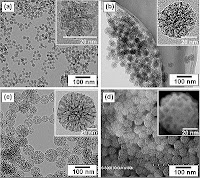A few Interesting applications of Nanotechnology...
The field of science which looks forward a boom every day is definitely, nanotechnology. It deals with particles that are very small in size( about 10^-9 m).The main idea upon which nanotechnology relies is that the original properties (either physical or chemical) of a substance gets changed when the size of the substance is reduced to nanoscale. Below given are a few interesting applications of nanotechnology…
• When water is simply allowed to flow through copper nanotubes, an emf is generated along the surface of the tubes( thereby generating current). The current produced is directly proportional to the speed of the water.
• Gold and silicon nanoparticles are red but their original colour in bulk state is yellow and grey respectively. These elements have their melting points 4 times reduced being in the nanoscale than being in a bulk state.
• Photovoltaic cells (which generate current from solar energy), made up of nanoparticles absorb more energy than the thin film sheets of normal semiconductors.
• Within the polymer matrices of plastics, clay nanoparticles are embedded for additional strength (extra 100%) and reinforcements.
• Dendrimers are nano materials made with the structure of a bacterium (E.Coli). Its flagellum is used for quicker transportations through fluids and so dendrimers are used in the Smart Drug Delivery System (SDDS) in our body.
• Transistors made of semiconductors in nanoscale provide higher dielectric constant and electron mobility making them more efficient. Nanoelectronics is based upon such transistors and other devices.
• Recently, a programmable molecular computing made of enzymes and DNA molecules is been invented. It doesn’t use any of the semiconductor devices.
Marvels from nanotechnology exist in both sides. It is wonderful as much as it is dangerous. Researches on the negative effect of the nano materials are taken into prime considerations before approving a technology. A few disadvantages are:
• High surface to volume ratio makes almost all nanoparticles highly reactive. And so, it is very doubtful that all reactions can be controlled to the required level.
• Certain nanoparticles in air can penetrate cells and tissues and can cause severe biochemical damage in functioning organs.
• Hydrocarbon nanoparticles ( from pollution) can damage cardiovascular system.
• When water is simply allowed to flow through copper nanotubes, an emf is generated along the surface of the tubes( thereby generating current). The current produced is directly proportional to the speed of the water.
• Gold and silicon nanoparticles are red but their original colour in bulk state is yellow and grey respectively. These elements have their melting points 4 times reduced being in the nanoscale than being in a bulk state.
• Photovoltaic cells (which generate current from solar energy), made up of nanoparticles absorb more energy than the thin film sheets of normal semiconductors.
• Within the polymer matrices of plastics, clay nanoparticles are embedded for additional strength (extra 100%) and reinforcements.
• Dendrimers are nano materials made with the structure of a bacterium (E.Coli). Its flagellum is used for quicker transportations through fluids and so dendrimers are used in the Smart Drug Delivery System (SDDS) in our body.
• Transistors made of semiconductors in nanoscale provide higher dielectric constant and electron mobility making them more efficient. Nanoelectronics is based upon such transistors and other devices.
• Recently, a programmable molecular computing made of enzymes and DNA molecules is been invented. It doesn’t use any of the semiconductor devices.
Marvels from nanotechnology exist in both sides. It is wonderful as much as it is dangerous. Researches on the negative effect of the nano materials are taken into prime considerations before approving a technology. A few disadvantages are:
• High surface to volume ratio makes almost all nanoparticles highly reactive. And so, it is very doubtful that all reactions can be controlled to the required level.
• Certain nanoparticles in air can penetrate cells and tissues and can cause severe biochemical damage in functioning organs.
• Hydrocarbon nanoparticles ( from pollution) can damage cardiovascular system.
On enjoying, the benefits of this immensely powerful technology, we must not let loose about the precautions we must take or follow. This doesn’t mean research interest over nanoscience should reduce. Just that all the essential factors are to be considered at an optimum level to gain most profits and least losses from it…



Comments
Post a Comment